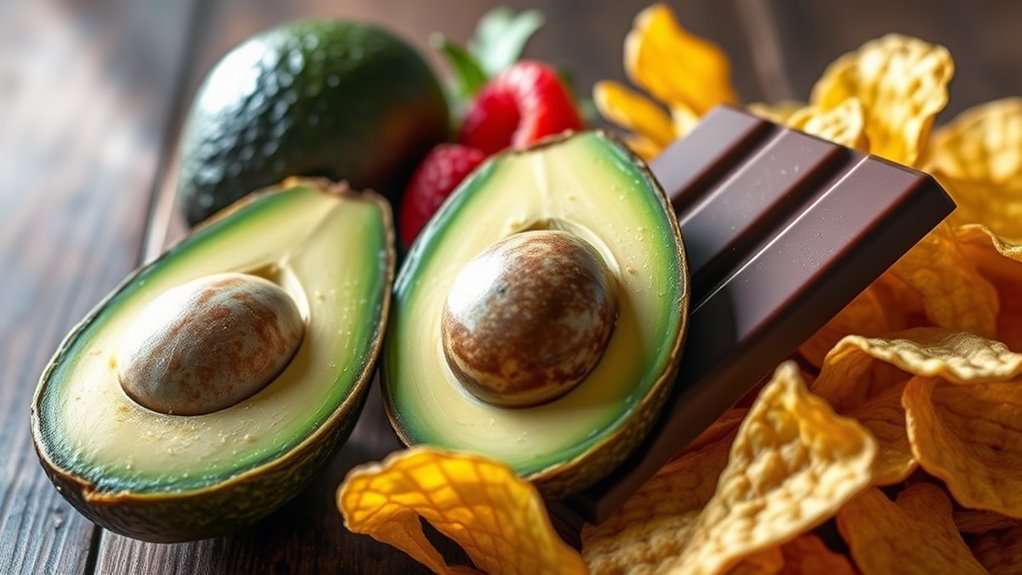Foods You’re Eating That Secretly Cause Breakouts – You’ll Be Surprised
You might be surprised to learn that certain foods can secretly cause breakouts. Dairy products, sugary snacks, and processed meats trigger inflammation and increase oil production in your skin. High glycemic index foods like white bread and chocolate can raise insulin levels, exacerbating breakouts. Additionally, certain vegetable oils can disrupt your skin’s balance. Monitoring and adjusting your diet may improve your complexion. Keep exploring to uncover more potential culprits behind those pesky breakouts.
Key Takeaways
- Dairy products, especially milk and cheese, can increase oil production and worsen acne due to hormones and IGF-1.
- Sugary snacks and high glycemic index foods lead to insulin spikes, exacerbating inflammation and contributing to breakouts.
- Processed meats contain hormones and preservatives that trigger inflammation, leading to increased oil production and skin issues.
- Milk chocolate, high in fat and sugar, elevates insulin levels, stimulating sebum production and potentially causing breakouts.
- Incorporating whole grains, fruits, and vegetables can improve skin health and mitigate breakout risks.
Dairy Products
[Dairy products, particularly milk and cheese, may contribute to breakouts in some individuals.
Research suggests that the hormones present in dairy can stimulate oil production in your skin, leading to clogged pores and, ultimately, acne. When you consume these foods, they may exacerbate inflammatory responses, making existing acne more pronounced.
Additionally, the insulin-like growth factor (IGF-1) in milk can increase sebum production, a key factor in the development of acne. Studies have shown that certain diets high in dairy can correlate with increased acne severity.
If you’re struggling with breakouts, it might be wise to evaluate your dairy intake. Consider substituting dairy products with non-dairy alternatives to see if your skin improves.
Understanding how these foods that cause acne affect your skin can empower you to make informed dietary choices for clearer skin.
Sugary Snacks
Sugary snacks often have a high glycemic index, which can lead to spikes in insulin levels and trigger hormonal fluctuations that contribute to breakouts.
When you consume these snacks, your body reacts by producing more sebum, increasing the likelihood of clogged pores. Exploring alternative snack options may help maintain balanced skin and reduce the risk of acne. Additionally, high glycemic index foods can exacerbate inflammation, further complicating skin health.
High Glycemic Index Impact
When you consume foods with a high glycemic index, like sugary snacks, your body experiences a rapid spike in blood sugar levels.
This sudden increase stimulates insulin production, which can lead to inflammation and an uptick in oil production in your skin. As a result, clogged pores emerge, creating an environment conducive to acne development.
Moreover, these spikes can cause a cascade of hormonal responses that may further exacerbate skin issues. The connection between high glycemic index foods and breakouts is well-documented, emphasizing the need for careful dietary choices.
Hormonal Fluctuations Explained
While indulging in sugary snacks may seem harmless, they can trigger significant hormonal fluctuations in your body. The rapid spike in blood sugar prompts your pancreas to release insulin. Elevated insulin levels can increase androgen production, leading to heightened oil production in your skin. This process contributes directly to acne formation.
Consider the following effects:
-
Insulin Spikes: Cause increased oil production.
-
Androgen Overproduction: Stimulates sebaceous glands.
-
Inflammation Increase: Triggers immune response, worsening breakouts.
-
Glycation: Damages collagen, promoting skin aging.
-
Cortisol Release: Stress hormones can exacerbate skin issues.
Understanding these hormonal changes can empower you to make informed dietary choices, potentially reducing breakouts linked to those seemingly innocent sugary snacks.
Alternative Snack Options
Finding healthier alternatives to sugary snacks is vital for maintaining clear skin and overall health. Instead of reaching for candy or pastries, consider incorporating fresh fruits, such as berries or apples, which provide natural sweetness along with essential vitamins.
Nuts offer a satisfying crunch while supplying healthy fats and protein, helping to regulate blood sugar levels. Greek yogurt is an excellent choice, rich in probiotics and low in sugar; it can be enhanced with honey or cinnamon for flavor.
Additionally, dark chocolate, with a cocoa content of at least 70%, can satisfy your sweet tooth without the excessive sugar found in traditional sweets.
Processed Meats
Processed meats often contain added hormones and preservatives that can trigger inflammation in your body.
This inflammation can lead to increased oil production and clogged pores, contributing to breakouts.
Additionally, the high sodium content in these meats may exacerbate skin issues by promoting water retention and swelling.
Hormones and Inflammation Connection
As you consume processed meats, it’s important to recognize their potential impact on your hormonal balance and inflammation levels.
These foods can trigger an inflammatory response, leading to increased sebum production and skin breakouts. High in saturated fats and additives, processed meats can disrupt hormone regulation, exacerbating acne issues.
Consider the following factors:
-
Hormonal fluctuations: Processed meats may elevate cortisol levels.
-
Inflammatory compounds: These foods often contain preservatives that provoke inflammation.
-
Gut health impact: A disrupted microbiome can lead to skin issues.
-
Insulin resistance: High glycemic responses can worsen acne.
-
Omega-6 fatty acids: Imbalance with omega-3 can promote inflammation.
Being mindful of your processed meat intake can be crucial for maintaining clear skin.
High Sodium Effects
Excessive sodium intake from processed meats can significantly impact your skin health. High sodium levels lead to dehydration, causing your body to retain water, which can manifest as puffiness and breakouts.
Furthermore, sodium-rich diets disrupt the balance of essential nutrients, potentially triggering inflammatory responses in your skin. This inflammation can exacerbate existing acne or induce new breakouts.
Processed meats often contain preservatives and additives that not only contribute to sodium content but also introduce additional skin-aggravating chemicals.
To maintain optimal skin clarity, consider reducing your processed meat consumption and opting for fresh, whole foods that support hydration and nutrient balance.
White Bread and Pasta
White bread and pasta, staples in many diets, can significantly influence skin health due to their high glycemic index. Consuming these refined carbohydrates leads to rapid spikes in blood sugar, triggering inflammation and excess oil production. This process can ultimately result in clogged pores and breakouts.
Consider these aspects:
- High glycemic index promotes insulin spikes.
- Insulin encourages sebum production, exacerbating acne.
- Refined carbohydrates lack essential nutrients for skin repair.
- White bread and pasta can contribute to systemic inflammation.
- A diet rich in whole grains may mitigate these effects.
In fact, systemic inflammation caused by these foods can worsen existing acne conditions. To maintain optimal skin health, consider reducing your intake of white bread and pasta while opting for whole grain alternatives that stabilize blood sugar levels and promote overall well-being.
Chocolate
While many people enjoy chocolate as a sweet treat, its potential to trigger breakouts shouldn’t be overlooked. The relationship between chocolate and acne largely stems from its fat and sugar content, which can lead to increased insulin levels. Elevated insulin stimulates sebum production, clogging pores and creating an environment conducive to acne development.
Moreover, certain compounds in chocolate, especially in milk chocolate, can provoke inflammatory responses in the body. These responses may exacerbate existing skin issues. Additionally, habits that worsen acne, such as excessive sugar consumption, can further complicate the skin’s condition.
If you’re prone to breakouts, consider monitoring your chocolate intake and opting for dark chocolate, which contains fewer sugars and may have beneficial antioxidants.
Ultimately, understanding how chocolate affects your skin can empower you to make informed dietary choices to maintain a clearer complexion.
High Glycemic Index Foods
When you consume high glycemic index foods, your body experiences rapid spikes in blood sugar levels, which can significantly impact your skin. Elevated insulin levels can lead to increased oil production and inflammation, both of which contribute to breakouts. Additionally, preventing acne is not just about what you eliminate but also about what you incorporate into your diet.
To maintain healthier skin, it’s crucial to be mindful of these foods.
- White bread
- Sugary cereals
- Potatoes
- Pastries
- Soft drinks
Opting for low glycemic index alternatives can help stabilize your blood sugar and reduce the likelihood of acne.
Incorporating whole grains, legumes, and most fruits and vegetables into your diet can promote a clear complexion while providing essential nutrients.
Understanding these dietary choices empowers you to take control of your skin health.
Certain Vegetable Oils
Certain vegetable oils, particularly those high in omega-6 fatty acids, can exacerbate skin issues like acne. These oils, commonly found in processed foods and cooking oils, include soybean, corn, and sunflower oils.
Omega-6 fatty acids promote inflammation, which can trigger acne flare-ups. When you consume these oils excessively, they can disrupt the balance of omega-3 and omega-6 fatty acids in your body, leading to heightened inflammatory responses.
To mitigate this risk, consider replacing these oils with healthier alternatives rich in omega-3s, such as flaxseed or walnut oil. Additionally, focus on whole foods and minimize processed items in your diet.




